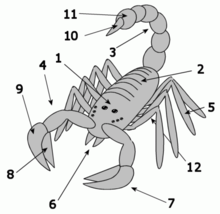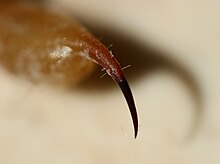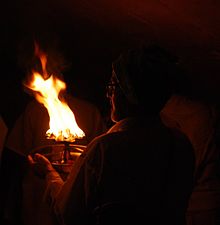SCORPION
Scorpions are predatory arthropod animals of the order Scorpiones within the class Arachnida. They have eight legs and are easily recognised by the pair of grasping pedipalps and the narrow, segmented tail, often carried in a characteristic forward curve over the back, ending with a venomous stinger. Scorpions range in size from 9 mm (Typhlochactas mitchelli) to 20 cm (Hadogenes troglodytes).[1]
The evolutionary history of scorpions goes back to the Silurian era 430 million years ago. They have adapted to a wide range of environmental conditions and can now be found on all continents except Antarctica. Scorpions number about 1750 described species,[2] with 13 extant families recognised to date. Only about 25 of these species are known to have venom capable of killing a human being.[3]:1The taxonomy has undergone changes and is likely to change further, as genetic studies are bringing forth new information.
Geographical distribution[edit]
Scorpions are found on all major land masses except Antarctica. Scorpions did not occur naturally in Great Britain, New Zealand and some of the islands in Oceania, but now have been accidentally introduced in some of these places by human trade and commerce.[3]:249 The greatest diversity of scorpions in the Northern Hemisphere is to be found in the subtropical areas lying between latitudes 23° N and 38° N. Above these latitudes, the diversity decreases, with the northernmost occurrence of scorpions being the northern scorpion Paruroctonus boreus at Medicine Hat, Alberta, Canada 50° N.[3]:251
Today, scorpions are found in virtually every terrestrial habitat, including high-elevation mountains, caves and intertidal zones, with the exception of boreal ecosystems, such as thetundra, high-altitude taiga and the permanently snow-clad tops of some mountains.[3]:251–252[7] As regards microhabitats, scorpions may be ground-dwelling, tree-living, lithophilic(rock-loving) or psammophilic (sand-loving); some species, such as Vaejovis janssi, are versatile and found in every type of habitat in Baja California, while others occupy specialised niches such as Euscorpius carpathicus, which occupies the littoral zone of the shore.[8]
Five colonies of scorpions (Euscorpius flavicaudis) have established themselves in Sheerness on the Isle of Sheppey in the United Kingdom.[9] This small population has been resident since the 1860s, having probably arrived with imported fruit from Africa. This scorpion species is small and completely harmless to humans. This marks the northernmost limit where scorpions live in the wild.[10][11]
Classification[edit]
Main article: Taxonomy of scorpions
There are thirteen families and about 1,750 described species and subspecies of scorpions. In addition, there are 111 described taxa of extinct scorpions.[12]
This classification is based on that of Soleglad & Fet (2003),[13] which replaced the older, unpublished classification of Stockwell.[14] Additional taxonomic changes are from papers by Soleglad et al. (2005).[15][16]
Systematics[edit]
The following classification covers extant taxa to the rank of family.
- Order Scorpiones
Fossil record[edit]
Proscorpius osborni, fossil scorpion initially thought to be a eurypterid
Scorpions have been found in many fossil records, including marine Silurian and estuarine Devonian deposits, coal deposits from the Carboniferous Period and in amber. The oldest known scorpions lived around 430 million years ago in the Silurian period. Though once believed to have lived on the bottom of shallow tropical seas,[17] early scorpions are now believed to have been terrestrial and to have washed into marine settings together with plant matter. These first scorpions were believed to have had gills instead of the present forms' book lungs though this has subsequently been refuted.[18][19][20] The oldest Gondwanan scorpiones (Gondwanascorpio) comprise the earliest known terrestrial animals from Gondwana.[21]Currently, 111 fossil species of scorpion are known.[12] Unusually for arachnids, there are more species of Palaeozoic scorpion than Mesozoic orCenozoic ones.
The eurypterids, marine creatures that lived during the Paleozoic era, share several physical traits with scorpions and may be closely related to them. Various species of Eurypterida could grow to be anywhere from 10 centimetres (3.9 in) to 2.5 metres (8.2 ft) in length.[22] However, they exhibit anatomical differences marking them off as a group distinct from their Carboniferous and Recent relatives. Despite this, they are commonly referred to as "sea scorpions".[23] Their legs are thought to have been short, thick, tapering and to have ended in a single strong claw; it appears that they were well-adapted for maintaining a secure hold upon rocks or seaweed against the wash of waves, like the legs of a shore crab.
Morphology
Scorpion anatomy:
1 = Cephalothorax or Prosoma;
2 = Abdomen or Mesosoma;
3 = Tail or Metasoma;
4 = Claws or Pedipalps
5 = Legs;
6 = Mouth parts or Chelicerae;
7 = pincers or Chelae;
8 = Moveable claw or Tarsus;
9 = Fixed claw or Manus;
10 = Sting or Aculeus ;
11 = Telson (follows anus in previous joint).
Sting of an Arizona bark scorpion
The body of a scorpion is divided into three parts (tagmata): the head (cephalothorax), the abdomen(mesosoma) and the tail (metasoma).[3]:10
Cephalothorax[edit]
The cephalothorax, also called the prosoma, comprises the carapace, eyes, chelicerae (mouth parts), pedipalps (the pedipalps of scorpions have chelae, commonly called claws or pincers) and four pairs of walking legs. The scorpion's exoskeleton is thick and durable, providing good protection from predators. Scorpions have two eyes on the top of the cephalothorax, and usually two to five pairs of eyes along the front corners of the cephalothorax. The position of the eyes on the cephalothorax depends in part on the hardness or softness of the soil upon which they spend their lives.[24]
The pedipalp is a segmented, chelate (clawed) appendage used for prey immobilisation, defence and sensory purposes. The segments of the pedipalp (from closest to the body outwards) are coxa, trochanter, femur (humerus), patella, tibia (including the fixed claw and the manus) and tarsus (moveable claw).[25] A scorpion has darkened or granular raised linear ridges, called "keels" or carinae on the pedipalp segments and on other parts of the body, which are useful taxonomically.[3]:12
Mesosoma
The abdomen, also called the opisthosoma, consists of seven segments (somites), each covereddorsally by a sclerotosed plate (tergum) and also ventrally for segments 3 to 7. The first abdominal segment bears a pair of genital opercula covering the gonopore. Segment 2 consists of the basal plate with the pectines, which are a pair of limbs transformed into sensory organs.[26] Each of the mesosomal segments 3 to 7 have a pair of spiracles, the openings for the scorpion's respiratory organs, known as book lungs. The spiracle openings may be slits, circular, elliptical, or oval.[3]:13–15
Metasoma
The metasoma, the scorpion's tail, comprises five caudal segments (the first tail segment looks like a last mesosoman segment) and the sixth bearing the telson (the sting). The telson, in turn, consists of the vesicle, which holds a pair of venom glands, and the hypodermic aculeus, the venom-injecting barb.
On rare occasions, scorpions can be born with two metasomata (tails). Two-tailed scorpions are not a different species, merely a genetic abnormality.[27]
Fluorescence
A scorpion under a black light. In normal lighting, this scorpion appears black.
Scorpions are also known to glow when exposed to certain wavelengths of ultraviolet light such as that produced by a black light, due to the presence of fluorescent chemicals in the cuticle. One fluorescent component is now known to be beta-carboline.[28] A hand-held UV lamp has long been a standard tool for nocturnal field surveys of these animals. Fluorescence occurs as a result of sclerotisation and increases in intensity with each successive instar.[28] This fluorescence may have an active role in scorpion light detection.








